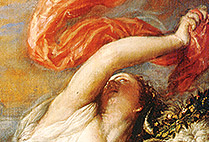Brendan Powell Smith pulls back his curly hair and scans the bins filled with tiny plastic heads, capes, wigs, limbs, glasses, animals, and guns that surround him. He knows that what he really needs to build the base of a convincing guillotine is his container of brown LEGO bricks.
The chopping block is needed for a pivotal scene in his new book, Revolution!: The Brick Chronicle of the American Revolution and the Inspiring Fight for Liberty and Equality That Shook the World, to be published in October 2014 and illustrated with full-page photographs of scenes constructed entirely with LEGO. Half of the book tells the story of the American Revolution; half is dedicated to the French Revolution.
Smith (CAS’95), who works at a table inside his San Francisco–area studio, snaps the brown blocks together to form the base of the guillotine, which he’ll use to illustrate the execution of Louis XVI. The French king met his fate in 1793 after being convicted of conspiring with foreign powers. When Smith is finished, the diorama-like scene will contain dozens of characters set in a French public square.
“History is full of violence, and I like that violence done in LEGO walks a fine line between disturbing, funny, and poignant,” says Smith, who has published 15 books, all illustrated with the bricks. “That’s where I like my work to be. LEGO is an interesting art medium and a wonderful creative challenge. It makes some of the more dramatic and gory parts of history more palatable.”
A word of caution before you rush to the bookstore to buy Revolution! for your child. While the PG-rated LEGO Movie (which earned $468 million globally at the box office) and the LEGOLAND theme parks (operating in the United States, Germany, and Malaysia) are aimed at a younger clientele, most of Smith’s work is intended for adults who grew up with hundreds of the tiny blocks strewn across their bedroom floor. In fact, it targets adults who can find humor in the bits of the macabre and the brutality that embellish the tales.

Smith’s scene of King Louis XVI at the guillotine. Louis met his fate in 1793 after being convicted of conspiring with foreign powers. Photo courtesy of Brendan Powell Smith
Smith, who grew up in Norwood, Mass., was given his first LEGO set—a windmill—at the age of three. He played with LEGO on and off through adolescence and amassed an impressive collection by buying old sets on eBay.
While Smith is a steadfast atheist, he spent a lot of time holed up with the Bible while studying religion and philosophy at BU. He chose the major to test his own beliefs and to learn the best arguments for and against religious belief. He also was fascinated with ancient history and the origins of religions, particularly Christianity and Judaism.
He learned that the good book is rich with great storytelling, plus a heavy helping of sex, violence, and nudity, which isn’t often discussed in Sunday school.
“The School of Theology is where atheist author Michael Martin [a College of Arts & Sciences professor emeritus of philosophy] was teaching, and where Paula Fredriksen [William Goodwin Aurelio Professor Emerita of the Appreciation of Scripture] was teaching about the origins of Christianity, despite having authored books making the case that Jesus was a mere mortal Jewish apocalyptic preacher rather than a divine figure,” he says. “So I was hardly the only skeptic there.”
In 2001, Smith began re-creating the Bible in LEGO and posting pictures of his scenes on his Brick Testament website. To his surprise, the site quickly received 20,000 hits, as well as publicity in publications such as Time and Wired magazines. He later partnered with a publisher to turn his art into two coffee-table size books with more than 2,000 illustrations spanning both the Old and New Testaments. When parents who bought the books for their children complained about the depictions of blood and nudity, Smith saw opportunity: he created a series of child-friendly Bible stories, such as David and Goliath and Jonah and the Whale.
“I’m flattered that my work has appealed to people across a wide spectrum of belief,” says Smith. “Atheists enjoy how the books point out the absurdities of the Bible, and ministers and Sunday school teachers appreciate that the project stays very true to the scriptures. I try to put very little spin or bias into my work.”

Smith photographs a finished LEGO scene to include in his latest book. Photo by Mitch Tobias
Smith recently turned his attention to American history, and last November published Assassination!: The Brick Chronicle of Attempts on the Lives of Twelve US Presidents, which illustrates attempts on the lives of John F. Kennedy, Abraham Lincoln, Ronald Reagan, and others. The book includes scenes such as Andrew Jackson fighting off his would-be assassin with a cane and Theodore Roosevelt’s continued delivery of a speech despite being shot in the chest.
The books take about four months of research and writing (each scene has some short accompanying text) before Smith begins building the scenes with LEGO. With few exceptions, every scene is created with LEGO-designed pieces. (For Assassination! he hired an artist to paint the faces of the presidents onto blank LEGO heads.) He mixes and matches characters and accessories from different sets. The style of dress in the LEGO bricksets based on Disney’s Pirates of the Caribbean, for example, is close enough for any scene in early American history.
Smith confesses that he “managed to squeeze” some zombie heads into the Bible books—for example, in his illustration of Matthew 27:51–53, where the dead were brought to life once Jesus died (“The earth shook, the rocks split and the tombs broke open. The bodies of many holy people who had died were raised to life. They came out of the tombs after Jesus’ resurrection and went into the holy city and appeared to many people.”).
With a LEGO collection so large—Smith estimates that he has somewhere around 250,000 pieces—organization is a challenge. He stores his LEGO in plastic containers; a custom-made gutter system around his worktable’s perimeter catches pieces that fall and sends them into a bin below. Padded mats make it easier for Smith to stand (in comfy bowling shoes) for several hours building a scene.
What comes after Revolution? Smith says he may go back in time, to the Inquisition. “There are such great stories throughout history, and it wasn’t until I was illustrating in LEGO that I was able to appreciate that,” he says. “You can kind of miss the narrative when there is just text, but seeing famous scenes illustrated helps your mind wrap around it in a different way.”
















































Related Stories
Were We a Nation under God from the Start?
BU input in Smithsonian’s American religious artifacts exhibition
Book Asks: Are Terrorists Cowards?
Chris Walsh breaks ground with Cowardice: A Brief History
Beauty and Anti-Semitism: The Gospel of John
Marsh Chapel dean’s new book on a great and troubling scripture
Post Your Comment